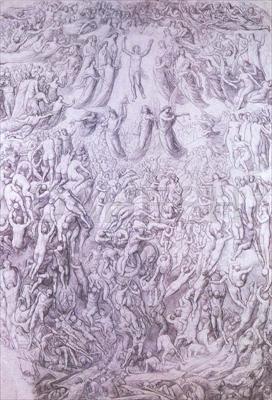Paul-Marc-Joseph Chenavard (French, 1807–1895)
The Last Judgment, 1888
Charcoal on blue-gray paper, 83 7/8 x 67 11/16 in.
2001.7

Paul Chenavard’s relatively small body of idiosyncratic works reflects the influence of Michelangelo and other Renaissance masters, whose work he first encountered during a trip to Italy in 1827. The circumstances surrounding this large Last Judgment drawing are unknown, but its densely packed and contorted bodies are reminiscent of those in his designs for a mural cycle at the Panthéon in Paris, a commission he received in 1848 from the Second Republic’s new arts administration—later cancelled and thus unrealized. Because that multifaceted commission was Chenavard’s primary focus for four years, and because his artistic output was limited generally, it is tempting to suggest that this drawing might be related to that project.
Vast crowds of the saved and damned, separated by a crowned Archangel Michael, surge and plummet chaotically, creating a nearly abstract pattern of swirling lines. Above the tumult, three angels blow the horns of the Last Judgment. One angel holds a triangle, symbol of the Trinity, and another, the scales that represent divine justice and the weighing of souls. At the top, surrounded by the elect, is Christ, who, in keeping with Chenavard’s humanistic theories, is not distinguished by the traditional halo.


